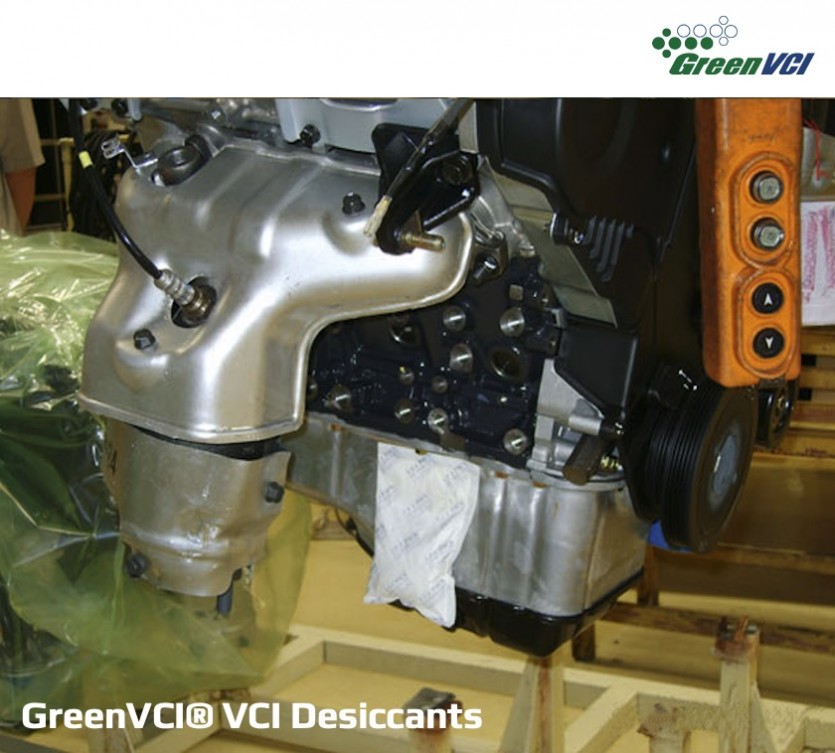Info
Archives
What is VCI desiccant?
2022.11.06
What is VCI Desiccant?
Desiccants can be classified into two main categories: physical and chemical moisture absorbers.
Most mineral desiccants, such as zeolite, bentonite, diatomite, activated carbon, silicon dioxide, and clay, fall under the category of physical moisture absorbers and have an average moisture absorption rate of 15-35%. These desiccants can absorb moisture, but only a few can absorb gases due to their physical properties and structure. Zeolite and activated carbon are particularly effective in absorbing gas. There are also synthetic zeolites and activated carbon products that can absorb both moisture and gas.
Attapulgite, a naturally mined clay, is used in the production of the VCI desiccant "GVD100." It has a unique property that allows it to selectively absorb moisture compared to other mineral desiccants. GVD100, also known as GreenVCI Desiccant 100 and its production code "VDPK" (VCI Desiccant Pack), was developed specifically for General Motors Korea and was patented in 2008. It offers two main functions: absorbing moisture and releasing volatile corrosion inhibitors into the vapor space of an enclosed area.
Chemical moisture absorbers, on the other hand, can absorb moisture at rates up to 400%. Calcium chloride is a common chemical moisture absorber due to its high absorption rate, but its physical property changes to a liquid state when it absorbs moisture, limiting its use in industry.
To address this issue, the VCI desiccant "GVD300" (also known as GreenVCI Desiccant 300 and its production code "SVD" meaning Super VCI Desiccant) was developed. It transforms calcium chloride into a gel formation after absorbing moisture and releases volatile corrosion inhibitors into the vapor space of an enclosed area like GVD100, but at a higher absorption rate of 150%. GVD300 is chemically engineered with a mixture of specially synthesized VCI powder chemicals and has a vapor pressure of 0.4-0.5 mmHg. This allows for temporary volatile corrosion inhibition, even after calcium chloride has absorbed moisture and changed form, whether it's in powder or gel form.
Special non-leaking, breathable papers should be used for calcium chloride desiccants to prevent water leakage and allow for vapor transmission. VCI desiccant sachets and VCI film are often used together in a corrosion protection package.
The patent for GVD300 was filed on June 4, 2018 and was officially registered on January 5, 2021. It is primarily composed of green VCI chemicals, food-grade calcium chloride, and super-absorbent natural polymers that transform its original powder substance into gel form after moisture absorption.
In conclusion, GreenVCI R&D Co., Ltd. also supplies the green VCI raw materials for GVD100 and GVD300 to other VCI and desiccant companies to produce their own attapulgite and calcium chloride-based VCI desiccants. Customizations for other types of desiccants are usually available upon request.
Desiccants can be classified into two main categories: physical and chemical moisture absorbers.
Most mineral desiccants, such as zeolite, bentonite, diatomite, activated carbon, silicon dioxide, and clay, fall under the category of physical moisture absorbers and have an average moisture absorption rate of 15-35%. These desiccants can absorb moisture, but only a few can absorb gases due to their physical properties and structure. Zeolite and activated carbon are particularly effective in absorbing gas. There are also synthetic zeolites and activated carbon products that can absorb both moisture and gas.
Attapulgite, a naturally mined clay, is used in the production of the VCI desiccant "GVD100." It has a unique property that allows it to selectively absorb moisture compared to other mineral desiccants. GVD100, also known as GreenVCI Desiccant 100 and its production code "VDPK" (VCI Desiccant Pack), was developed specifically for General Motors Korea and was patented in 2008. It offers two main functions: absorbing moisture and releasing volatile corrosion inhibitors into the vapor space of an enclosed area.
Chemical moisture absorbers, on the other hand, can absorb moisture at rates up to 400%. Calcium chloride is a common chemical moisture absorber due to its high absorption rate, but its physical property changes to a liquid state when it absorbs moisture, limiting its use in industry.
To address this issue, the VCI desiccant "GVD300" (also known as GreenVCI Desiccant 300 and its production code "SVD" meaning Super VCI Desiccant) was developed. It transforms calcium chloride into a gel formation after absorbing moisture and releases volatile corrosion inhibitors into the vapor space of an enclosed area like GVD100, but at a higher absorption rate of 150%. GVD300 is chemically engineered with a mixture of specially synthesized VCI powder chemicals and has a vapor pressure of 0.4-0.5 mmHg. This allows for temporary volatile corrosion inhibition, even after calcium chloride has absorbed moisture and changed form, whether it's in powder or gel form.
Special non-leaking, breathable papers should be used for calcium chloride desiccants to prevent water leakage and allow for vapor transmission. VCI desiccant sachets and VCI film are often used together in a corrosion protection package.
The patent for GVD300 was filed on June 4, 2018 and was officially registered on January 5, 2021. It is primarily composed of green VCI chemicals, food-grade calcium chloride, and super-absorbent natural polymers that transform its original powder substance into gel form after moisture absorption.
In conclusion, GreenVCI R&D Co., Ltd. also supplies the green VCI raw materials for GVD100 and GVD300 to other VCI and desiccant companies to produce their own attapulgite and calcium chloride-based VCI desiccants. Customizations for other types of desiccants are usually available upon request.

 EN
EN








